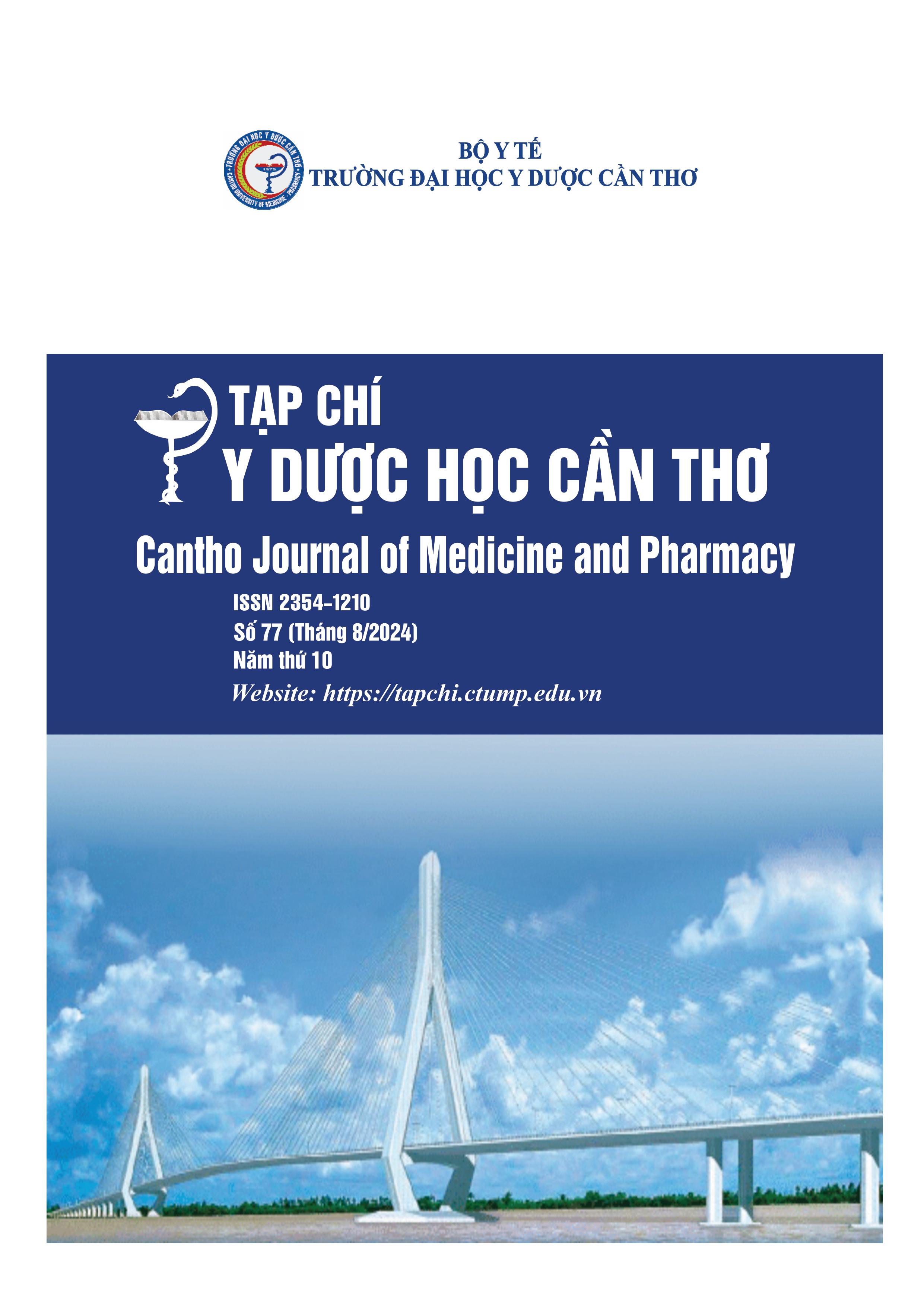IMAGING CHARACTERISTICS AND RELIABILITY OF COMPUTED TOMOGRAPHY AND MAGNETIC RESONANCE IMAGING IN THE DIAGNOSIS OF THORACOLUMBAR SPINE INJURY
Main Article Content
Abstract
Background: Thoracolumbar spine injury is a common surgical disease in Vietnam. Accurate diagnosis and instability assessment is essential to select the most appropriate treatment method. Determining the reliability of computed tomography with magnetic resonance in assessing spinal instability will be of great value in the treatment of patients with thoracolumbar spine injury.
Objectives: To study the imaging characteristics and reliability of computed tomography and magnetic resonance imaging in diagnosing thoracolumbar spine injury. Materials and methods: A prospective, cross-sectional descriptive study was conducted on patients with a clinical diagnosis of thoracolumbar spine injury, undergoing computed tomography and magnetic resonance imaging at the Can Tho Central General Hospital from July 2022 to May 2024. Results: A total of 35 patiens (10 men and 25 women, with the age of 18-86 years) were included in the study. The most common thoracolumbar injury level was T11–L2 (77.1%) while the least common level was T1–T10 (2.9%). There was moderate to almost perfect agreement between computed tomography and magnetic resonance imaging in assessing the instability of the thoracolumbar spine after injury with kappa ranging from 0.565 to 0.951 (p<0.001). Conclusions: The combination of computed tomography and magnetic resonance imaging plays an important role in diagnosing the location and morphology of fractures, damage to the spinal cord and surrounding soft tissue as well as determining instability of thoracolumbar spine injuries. Therefore, they are of great help in choosing the appropriate treatment for the patient.
Article Details
Keywords
Thoracolumbar spine injury, computed tomography, magnetic resonance imaging, reliability, instability
References
2. Pizones J., Castillo E. Assessment of acute thoracolumbar fractures: challenges in multidetector computed tomography and added value of emergency MRI. Semin Musculoskeletal Radiology. 2013. 17(4), 389-95, doi: 10.1055/s-0033-1356468.
3. Rajasekaran S., Vaccaro A.R., Kanna R.M., Schroeder G.D., Oner F.C., et al. The value of CT and MRI in the classification and surgical decision-making among spine surgeons in thoracolumbar spinal injuries. European Spine Journal. 2017. 26(5), 1463-1469, doi: 10.1007/s00586-016-4623-0.
4. Aly M.M., Al-Shoaibi A.M., Alzahrani A.J., Al Fattani A. Analysis of the Combined Computed Tomography Findings Improves the Accuracy of Computed Tomography for Detecting Posterior Ligamentous Complex Injury of the Thoracolumbar Spine as Defined by Magnetic Resonance Imaging. World Neurosurgery. 2021. 151, e760-e770, doi: 10.1016/j.wneu.2021.04.106.
5. Kim S., Yoon C.S., Ryu J.A., Lee S., Park Y.S., et al. A comparison of the diagnostic performances of visceral organ-targeted versus spine-targeted protocols for the evaluation of spinal fractures using sixteen-channel multidetector row computed tomography: is additional spine-targeted computed tomography necessary to evaluate thoracolumbar spinal fractures in blunt trauma victims?. The Journal of Trauma: Injury, Infection, and Critical Care. 2010. 69(2), 437-46, doi: 10.1097/TA.0b013e3181e491d8.
6. Lang S., Walter N., Freigang V., Neumann C., Loibl M., et al. Increased incidence of vertebral fractures in German adults from 2009 to 2019 and the analysis of secondary diagnoses, treatment, costs, and in-hospital mortality. Scientific Reports. 2023. 13(1), 6984, doi: 10.1038/s41598-023-31654-0.
7. Đỗ Mạnh Hùng, Vũ Văn Cường, Đỗ Anh Tuấn. Đặc điểm lâm sàng, chẩn đoán hình ảnh của các bệnh nhân gù cột sống đoạn bản lề ngực-thắt lưng sau chấn thương. Tạp chí y học Việt Nam. 2023. 528(2), 182-186, doi: 10.51298/vmj.v528i2.6109.
8. Almigdad A., Alazaydeh S., Mustafa MB., Alshawish M., Abdallat AA. Thoracolumbar spine fracture patterns, etiologies, and treatment modalities in Jordan. Journal of Trauma and Injury. 2023. 36(2), 98-104, doi: 10.20408/jti.2022.0068.
9. Joaquim A.F., Lawrence B., Daubs M., Brodke D., Tedeschi H., et al. Measuring the impact of the Thoracolumbar Injury Classification and Severity Score among 458 consecutively treated patients. The Journal of Spinal Cord Medicine. 2014. 37(1), 101-6, doi: 10.1179/2045772313Y.0000000134.
10. Lê Hữu Trì. Đặc điểm hình thái tổn thương và kết quả phẫu thuật điều trị gãy cột sống ngực, thắt lưng đa tầng. 2020. Học viện quân y. 124.
11. Baaj A.A., Gantwerker B. R., Theodore N., Uribe J. S., Vale F. L., et al. Radiographic assessment of thoracolumbar fractures based on axial zones. Journal of Spinal Disorders and Techniques. 2014. 27(2), 59-63, doi: 10.1097/BSD.0b013e318250ebf0. 12. Ngô Tuấn Tùng. Đánh giá kết quả phẫu thuật chấn thương cột sống đoạn bản lề ngực – thắt lưng mất vững tại bệnh viện Hữu nghị Việt Đức. Đại học Y Hà Nội. 2015. 88.
13. Lewkonia, P., Paolucci E.O., Thomas K. Reliability of the thoracolumbar injury classification and severity score and comparison with the denis classification for injury to the thoracic and lumbar spine. Spine (Phila Pa 1976). 2012. 37(26), 2161-7, doi:
10.1097/BRS.0b013e3182601469.
14. Denis F. The three column spine and its significance in the classification of acute thoracolumbar spinal injuries. Spine (Phila Pa 1976). 1983. 8(8), 817-31, doi: 10.1097/00007632-19831100000003.
15. Khurana B., Prevedello L. M., Bono C. M., Lin E., McCormack S. T., et al. CT for thoracic and lumbar spine fractures: Can CT findings accurately predict posterior ligament complex injury?. European Spine Journal. 2018. 27(12), 3007-3015, doi: 10.1007/s00586-018-5712-z.


